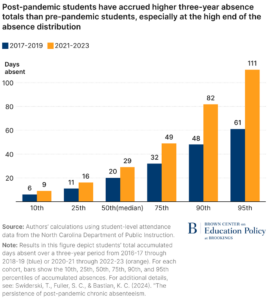I thought I understood the chronic absenteeism problem. Kids were disengaged during the pandemic and lost the habit of going to school regularly. Plus, the virus and flu were still circulating, which forced kids to stay home.
That story is a generic one. The virus and flu should affect all kids equally, right?
A new chart from Tom Swiderski, Sarah Crittendon Fuller, and Kevin C. Bastian made me see the problem in a new way. They used attendance data in North Carolina to compare attendance rates pre-pandemic, from 2017-2019, with post-pandemic  rates, from 2021-2023. As you can see in the graph, from the author’s summary for Brookings, attendance has gotten worse across the spectrum.
rates, from 2021-2023. As you can see in the graph, from the author’s summary for Brookings, attendance has gotten worse across the spectrum.
All kids are missing more school. But the changes have been far from universal. At the higher end, kids at the 10th percentile went from missing a total of six days of school in the three years pre-pandemic to missing nine days in the three years post-pandemic. On an annual basis, the median student missed about 3 more days of school.
Now look at the right side of the chart. Kids at the 95th percentile missed an average of 61 days in the three years leading up to the pandemic. That number jumped to 111 days (!) in the three years post-pandemic.
These are three-year totals. To put them on an annual basis, the kids with the best attendance are missing about an extra day of school per year, but the kids with the worst attendance records are missing multiple weeks worth of school time.
In other words, all kids have been missing more school, but some kids have been missing WAY more school.
The authors conclude that, “the experience of chronic absenteeism has become widespread while also becoming persistent and concentrated for a meaningful subset of students….These students may need more, and more unique and targeted, intervention to re-engage with school successfully.”
What can state and district leaders do about the attendance problem in their communities? Check out my interview with Phyllis Jordan about the FutureEd Attendance Playbook. Or, our expert panel of reviewers recommended a Connecticut initiative called the Learner Engagement and Attendance Program (LEAP) as an evidence-based approach to re-engage students after COVID.
Students can’t learn if they’re not in school. The latest data suggest that the attendance problem is widespread, but it’s particularly concentrated among students who are missing lots of school. State and district leaders need solutions that are targeted to addressing those problems.

